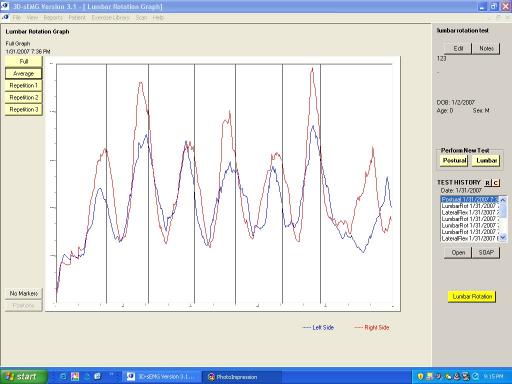Comparing lumbar rotation muscle activation levels in an upright weight bearing poition - before, and during an ATM2 treatment.
Following are two graphs showing left and right lumbar muscle activation levels as a function of time while a subject is standing in an upright weight-bearing position and rotating his spine to the left and then to the right repeatedly. The first spinal rotation is to the left side.
So far we have done this with about 10-12 subjects and these improvements in muscle activation patterns are 100% repeatable.
Before ATM2 Treatment
Many studies have shown the essential nature of reciprocal inhibition that allows the antagonistic muscle to relax as the agonist elicits a concentric contraction. As can be seen in the “before” Surface EMG study, this essential relaxation is not occurring, but instead, the antagonistic muscle is activating quite extensively. This phenomenon is called many different things, but regardless of the name, it is NOT conducive to a proper path of motion of any given joint. The offending antagonistic muscle is performing an eccentric contraction as it is being lengthened and thus puts undue stresses on the related joint and also causes an altered path of motion, further stressing the joint.
This problem occurs due to the fact that when any given skeletal muscle is “Hyper” tonic, the excitation potential of that muscle is increased, thus causing it to activate before or, as can be seen here, even when it is supposed to be relaxing. This hyper tonicity may come from several different physiological aspects, but if the muscle spindle fibers are shortened as a result of a hypertonic muscle, they too would activate during any type of lengthening and therefore elicit the stretch reflex, causing the muscle to activate, even during lengthening. As seen here.
During ATM2 Treatment
By stabilizing the pelvis using the ATM 2, reciprocal inhibition can do it’s assigned task (causing the antagonistic muscle to relax) without the interference of the hyperactive muscle spindle fibers, thus retraining the antagonistic muscle and resulting in the proper path of motion of the joint, proper relaxation of the antagonistic muscle and alleviation of pain. (Note the proper relaxation of the antagonistic muscle after treatment as documented by this surface EMG study).
This positive result may further be enhanced and prolonged by performing a specific series of stretches for the hypertonic muscles.


